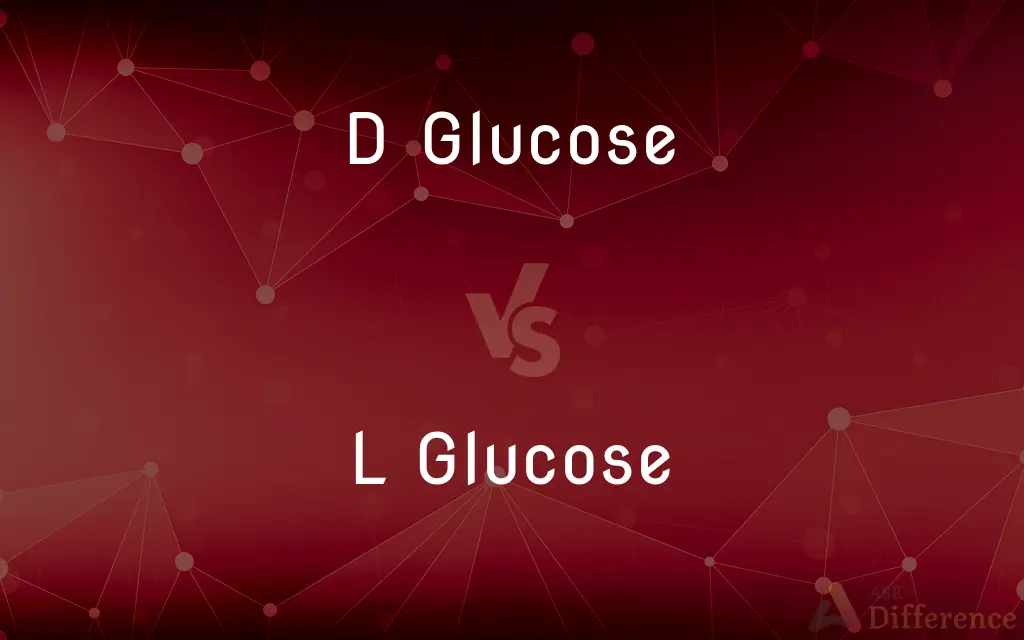D Glucose vs. L Glucose — What's the Difference?
Edited by Tayyaba Rehman — By Fiza Rafique — Published on October 16, 2023
D-Glucose and L-Glucose are stereoisomers of glucose, with D-Glucose being naturally occurring and metabolically active, while L-Glucose is its mirror image and not utilized by the body.

Difference Between D Glucose and L Glucose
Table of Contents
ADVERTISEMENT
Key Differences
D-Glucose and L-Glucose are intriguing examples of how molecular structures can drastically influence function.
D-Glucose, the most common form of glucose, is a simple sugar that serves as a primary energy source for many organisms. It's the primary form that's metabolized by our bodies. L-Glucose, on the other hand, is essentially the mirror image of D-Glucose.
While it might seem like a mere reflection wouldn't make much difference, in molecular biology, it does. L-Glucose isn't metabolized by the body in the same way. In fact, it's largely unutilized. If you think of enzymes as locks and sugars as keys, D-Glucose fits perfectly into our body's metabolic locks, but L-Glucose does not. It's a testament to how specific and precise biological systems are. The positioning of atoms and functional groups in these molecules determines their roles and functionalities in living systems.
Comparison Chart
Metabolic Activity
Metabolically active in the body.
Not metabolized by the body.
Natural Occurrence
Naturally occurring in most organisms.
Rarely found in nature.
ADVERTISEMENT
Mirror Image
Standard configuration for glucose.
Mirror image of D-Glucose.
Utilization
Used as an energy source by cells.
Not utilized as an energy source.
Enzymatic Interaction
Fits into the body's enzymes for metabolism.
Doesn't fit well into the body's metabolic enzymes.
Compare with Definitions
D Glucose
A primary energy source for many organisms.
The brain primarily relies on D-Glucose for energy.
L Glucose
Can be synthesized in labs but is rare in nature.
L-Glucose has been explored as a sugar substitute because of its taste.
D Glucose
The naturally occurring form of glucose.
Most of the glucose found in our food is D-Glucose.
L Glucose
A stereoisomer of D-Glucose.
The molecular structures of D-Glucose and L-Glucose are mirror images.
D Glucose
A monosaccharide carbohydrate.
D-Glucose is one of the building blocks for larger carbohydrates.
L Glucose
The non-natural mirror image of D-Glucose.
Though sweet, L-Glucose isn't used by our body for energy.
D Glucose
Can be derived from dietary starches and sugars.
Consuming rice, a starchy food, increases D-Glucose in the bloodstream.
L Glucose
Doesn't fit well into the body's metabolic enzymes.
Our enzymes aren't designed to metabolize L-Glucose.
D Glucose
Metabolically active in the human body.
After eating, blood levels of D-Glucose rise, triggering insulin release.
L Glucose
Not metabolically active in humans.
Consuming L-Glucose wouldn't raise your blood sugar levels.
Common Curiosities
Which form of glucose is found in our food?
D-Glucose is the naturally occurring form in most foods.
What makes D-Glucose and L-Glucose different?
They're mirror images of each other, with D-Glucose being metabolically active and L-Glucose not.
Why is D-Glucose important for the body?
D-Glucose is a primary energy source for cells, especially in the brain.
Why don't our enzymes metabolize L-Glucose?
Enzymes are specific in structure, and L-Glucose doesn't fit well.
Is D-Glucose the only form of glucose in nature?
While it's the predominant form, trace amounts of L-Glucose can be found.
How are D-Glucose and L-Glucose related to chirality?
They're chiral isomers, with molecules that are non-superimposable mirror images.
Can L-Glucose be used as a sweetener?
Yes, it's been explored as a sugar substitute because it tastes sweet but isn't metabolized.
Can our body utilize L-Glucose?
No, L-Glucose isn't metabolized by the body for energy.
Is L-Glucose harmful if consumed?
It's not harmful but also not utilized by the body for energy.
Can animals metabolize L-Glucose?
Like humans, most animals can't efficiently metabolize L-Glucose.
Where can L-Glucose be found?
L-Glucose can be synthesized in labs but is rare in nature.
Why is D-Glucose crucial for the brain?
The brain primarily uses D-Glucose as its energy source.
Are there other sugars with D and L forms?
Yes, many sugars have chiral forms, including D and L configurations.
How does L-Glucose taste compared to D-Glucose?
Both taste sweet, but the body only utilizes D-Glucose for energy.
How does the body respond to elevated D-Glucose levels?
It releases insulin to help cells absorb and use D-Glucose.
Share Your Discovery

Previous Comparison
Cruelty vs. Sadism
Next Comparison
Hair Removal Cream vs. WaxingAuthor Spotlight
Written by
Fiza RafiqueFiza Rafique is a skilled content writer at AskDifference.com, where she meticulously refines and enhances written pieces. Drawing from her vast editorial expertise, Fiza ensures clarity, accuracy, and precision in every article. Passionate about language, she continually seeks to elevate the quality of content for readers worldwide.
Edited by
Tayyaba RehmanTayyaba Rehman is a distinguished writer, currently serving as a primary contributor to askdifference.com. As a researcher in semantics and etymology, Tayyaba's passion for the complexity of languages and their distinctions has found a perfect home on the platform. Tayyaba delves into the intricacies of language, distinguishing between commonly confused words and phrases, thereby providing clarity for readers worldwide.
















































